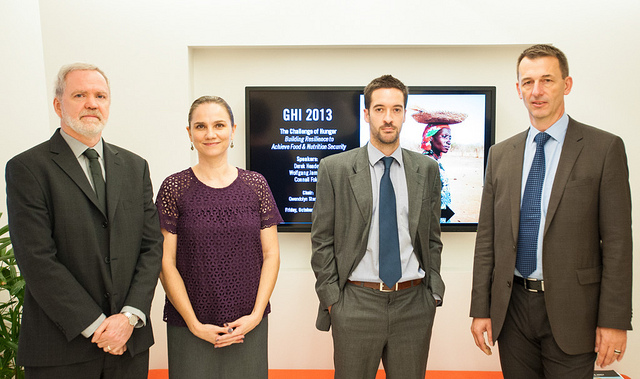Today’s era of food, financial, and weather-related crises, combined with household-level stressors, makes food and nutrition security for the world’s most vulnerable people ever more challenging. Research has shown that such groups not only spend a higher percentage of their household income on food, but also have fewer assets to help them cope with shocks.
Last week, experts from IFPRI, Concern Worldwide, and Welthungerhilfe gathered to discuss this year’s Global Hunger Index (GHI) report, Building Resilience to Achieve Food and Nutrition Security, which uses country-based data to assign countries an individual hunger “score” (from 1 to 100). They reflected on the current state of hunger in the world and discussed this year’s theme of resilience, explaining how it should shape the dialogue on food and nutrition security moving forward.
More than Bouncing Back
Resilience means “to bounce back,” though in the context of food and nutrition security, it’s more complex than that. According to IFPRI Senior Research Fellow Derek Headey, the definition depends on the magnitude and duration of the shock. For instance, with a relatively low-level shock, such as a short-term food-price increase, people might only need to make minor adjustments to cope. This is called absorptive capacity. However, for larger shocks, like consistently low rainfall, they might need to use what is called adaptive capacity, which could include activities such as planting new varieties of crops or changing their farm-management practices to conserve water. Finally, when facing major ongoing changes to their ecological, economic, or social structures (for example, during ongoing civil conflict), transformative capacity—the ability to make drastic changes to one’s livelihood—might be required.
In his presentation at the GHI launch, Director of Welthungerhilfe Wolfgang Jamann took this concept of resilience one step further. “One of the key issues in community resilience,” he said, “is that it’s not just a matter of bouncing back, it’s a matter of bouncing back better. The idea is to bring the community to a position where it is better than before a shock. So it’s not just recovering, it’s improving the situation.”
Beyond an “Emergency Economy”
To illustrate how resilience-building efforts can improve food security and income levels, Jamann shared some of his organization’s experiences in Haiti. In the wake of dozens of catastrophic weather events during the past decade, what emerged in Haiti was something Jamann calls an “emergency economy,” one in which the international relief community has a great deal of control over the allocation of basic public goods and services. To change this situation in Haiti and elsewhere, countries need to develop strategies that address the structural causes of food and nutrition insecurity before (another) disaster strikes.
Governments should also encourage national ministries and local communities to be the drivers of their own development. Jamann described a Welthungerhilfe study in northwest Haiti where smallholder farmers worked to improve their soil-management practices and, subsequently, following an acute crisis, observed lower rates of food deficits accompanied by higher farmer incomes.
Concern Worldwide’s Strategy Director Connell Foley also shared findings from his organization’s resilience work, which emphasized the importance of multisectoral approaches with capacity-strengthening elements. A Concern Worldwide impact analysis of a cash-transfer program in Ethiopia showed that the program was unable to meet food and nutrition security targets without also addressing the underlying causes of hunger and malnutrition, including poor soil- and water-management practices among farmers.
Bridging the Divide between Aid and Development
Some parts of Africa have received large quantities of humanitarian assistance for the past 30 years or more, so why do they still suffer chronic food insecurity? “Is traditional food aid undermining the food and nutrition security of recipient countries?” asked Headey. There was a consensus among the panelists that there needs to be better coordination between the relief and development sectors and that it’s high time to break down institutional and programmatic barriers that continue to prevent such efforts.
Working together to help build resilience might just be a way to bridge that divide.







